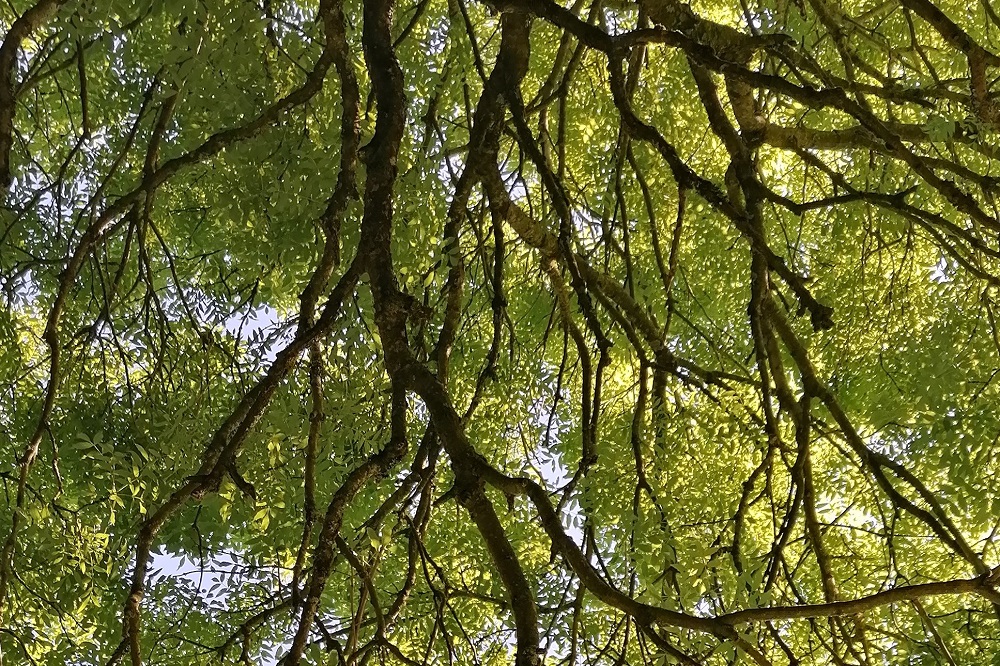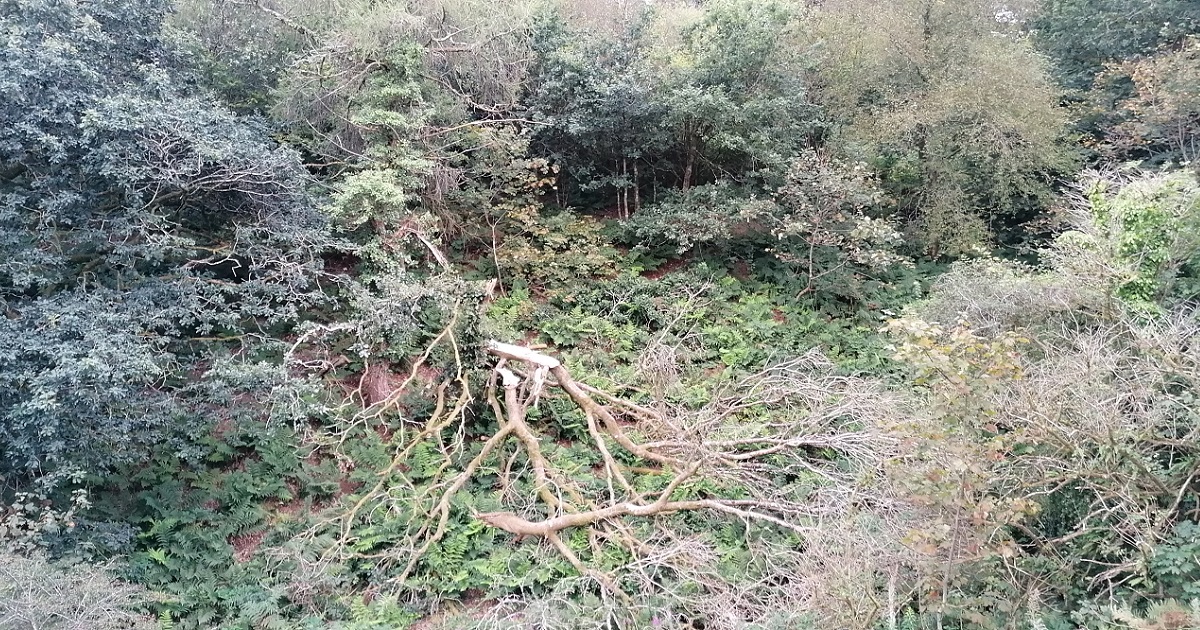Cynefin – A Sense of Place: Gog and Magog part 1

Gaynor Funnell
Trees are the guardian spirits of the land, therefore angels.
Roger Deakin
The oak tree fell down in January, pole-axed by a rare blast of northerly wind. The usual wind direction here is a wet and windy westerly – when the north wind blows, we rarely have snow, just fallen branches or trees.
Because of the way the land lies, the wind funnels up from the lower cwm, races upwards through the steep sides of the small valley lined with trees, and bursts into the widening woodland, forming miniature vortex’s that batter anything that gets in their way. And this time, Magog had been caught in the maelstrom.
Gog and Magog. A pair of sessile oaks I’d named after the two ancient oaks of Avalon who’d heralded the entrance onto the isle. They were part of a druidic avenue leading towards Glastonbury Tor and were themselves named after two biblical apocalyptical figures.
Reputedly 2000 years old, Magog is now reaching the end of her natural life and unfortunately the original Gog recently died following a fire.
The air is still today, full of the hush that often follows bad weather. It’s almost as if the earth is taking a breath to recover from the chaos of the day before.
Wisps of cloud, lace-white against the fresh blueness of the sky, travel slowly eastwards and drips of sunlight glisten on bark and bent-over grasses. The air smells of nothing – everything has been tumbled clean.
From my viewpoint on the deck opposite, my Gog looks lonely by himself. The two trees had stood so close to each other that their branches used to interdigitate, and in summer it was difficult to tell which one was which. Underground their network of roots would be doing the same – touching, communicating.
Nuthatches would scuttle up and down their branches, and squirrel used them as bridges, regardless of which one belonged to each tree. Sun and rain touched them equally, as did wind. Until the day of the storm.
Resonance
Maybe they both sprung from the same mother tree, even from the same year of harvest, as they’re similar in size. Or more likely, both trees are the results of uneaten bounty hidden by the Screecher of the Woods, or Ysgrech y Coed, the jay, its electric-blue wings and white rump flashing through the undergrowth as it searched for a spot amongst the thorny scrub to bury acorns.
The jay’s habit of burying them some distance from where they’ve been collected means that oak trees have spread outwards to the fields, and even uphill from the mother tree.
Magog has collapsed onto a bed of dry bracken, one of the only things that grows on this steep slope, pulling down a small hazel sapling in the process.
Her silvery, bare branches have spread like the tentacles of a beached jellyfish and the splintered remains of her trunk thrusts skywards, the exposed wood left naked and pale.
Patches of yellow-brown moss cover the elephant greyness of the trunk, and lichen which usually drips from the branches, is now dropping onto the ground. A few curls of bleached polypody fern still cling to the vee of a branch.
Even though their host is dead, I hope all these will survive. I can’t help but cry over the loss of something I thought of as a friend. Along with the notion that Gog must be missing her too. Once you give a name to something, it becomes something more.
It’s the comparison with Dave that also resonates. A tall, big presence of a man, brought down by a collection of rogue cells, a whirlwind causing destruction through his body. In my mind’s eye and in these early stages of grief, the similarity between the two is hard to ignore.

The gin deck
It’s the beginning of May and I look across at Gog and the fallen remains of Magog, still splayed across the hillside, from my vantage point on the deck on the opposite side of the bank.
Dave built this deck a number of springs ago, my ‘Gin deck’ he called it, although it has to be said that more tea has been drunk here than gin.
The deck is built at the side of the track that runs behind Shed field, where the old slurry pit used to be, and which leads from the farmyard to the lower fields – the old Cwm and the new Cwm.
Years ago, before we arrived, there was a spill from the slurry lagoon, causing cattle manure and water to pour down this side of the track, which then headed downwards towards the stream that trickles at the bottom of the valley, smothering all the low growing plants it touched.
The area is still bare of trees, apart from an amazingly contorted, senior hawthorn, which must have just missed the spill, and whose branches are black and knobbled and covered with lichen, and a squat and spreading hazel tree.
A splash of snowdrops
The space is like a miniature amphitheatre, surrounded by trees higher up the slope, either side and opposite, and over the years has filled with bracken and bramble and willowherb.
In March, a splash of snowdrops follows the path of the slurry spill and waterfall downwards, a bright white gash against the brown and emerging green of the scrub.
The deck juts out above this open area, and was built at this particular spot as Dave knew I loved looking out across the view, and if I could do it whilst sitting down with a pair of binoculars, even better.
There’s a 180-degree panoramic vision of it all, and it’s perfect for watching birds as they fly and swoop and dart from tree to tree to tree across the gap.
Even in the starkness of winter, or when its deluging rain, I always stop and look into the void, hoping to see something, anything.
Anxiety relieving
In summer, a leaning ash tree casts its shade over the rear of the deck. It’s always late into leaf and first in the wood to drop its still-green leaves.
Handfuls of lime-green keys dangle at a reachable hand height, and stay on the tree all winter, slowly turning a chestnut-brown and rustling with the slightest breath of air.
When the ash canopy is at its fullest, I lie on the bench and watch the leaves catching the sun and making patterns against the sky.
Is there anything more lovely or anxiety-relieving than the whisper of leaves and shades of green through sunlight?
Framed within the viewpoint of my deck, the trees I can see whilst sitting on the old, worn bench are Gog and Magog right at the front, plus two ash, nine birch, one sycamore, three hawthorn, five hazel, and one magnificent beech.
There’s also one spindle, two horse chestnuts, one larch, and five evergreen conifers, which were included as part of a previous planting scheme and not native to here.
Tiniest of birds
Although the conifers shouldn’t be in this wood, they may be the reason why goldcrests and the occasional firecrest can occasionally be seen, as both birds like to nest in conifers.
Their nest is a hammock-like structure made of lichen, moss and cobwebs, spiders being a major part of their diet.
They are both the tiniest of birds, approximately nine cm in length, and unless you get very close, are difficult to tell apart – the golden crown of the firecrest being more orange, with a black stripe through its eye and a white stripe above it.
They are also noisy, and the high-pitched jingly zig-zig of a call reverberates through the woodland, so I’ve heard them more often than I’ve seen them.
Some goldcrests are migratory and years ago people believed they travelled on the back of a woodcock or a short-eared owl, as it was thought they were too small to make the long journey from Scandinavia by themselves.
Warp and weft
The sun feels warm against my face as I sip my tea and listen the birds – chiffchaff, blackbird, blackcap, blue tit, great tit, plus the drumming from a greater spotted woodpecker lurking nearby.
A speckled wood butterfly spirals up from the dimness of the flora below, banana yellow spots bright against the chocolate brown of its wings, and a cluster of soot-black St. Marks Fly’s languorously glide above the rank grass, long legs dangling, wings a shimmering.
The enveloping trees are a warp and weft of different greens – mint, sage, apple, olive – all in various stages of leaf, although by august, the leaves will lose their spring newness and the colours will merge and blend into each other, as if copying a watercolour painting.
The wood is more than a collection of trees. You could put the exact same trees together in a different location, and it wouldn’t feel the same.
Place, and what it contains – wildlife, the soil, influence of the weather, history, myth, memories of people past and present – is everything.
The presence or sense you feel in a wood is greater than the sum of its parts.
Gaynor Funnell is the winner of the Nigel Jenkins award for 2022. We are delighted to be publishing a series about Penbanc over the coming months, with support from the H’mm Foundation.
You can read part one of the serialisation here
Support our Nation today
For the price of a cup of coffee a month you can help us create an independent, not-for-profit, national news service for the people of Wales, by the people of Wales.






